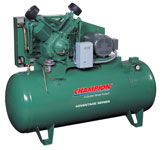The best thing you can do for your compressed air system is establishing a regular, well-organized maintenance program and strictly following it. Such a program is critical to maintaining the performance of a compressed air system and will save you time and money in the long haul. One person should be given the responsibility of ensuring that all maintenance is performed properly, on schedule, and is adequately documented.
Contact Us 1-888-229-9999
www.IndustrialAirCompressors.biz
Email: compressors@mcguire.biz
Owned and Operated by McGuire Air Compressors, Inc.
“Real People with Real Air Compressor Experience”

Ask a Question:
What are the standard recommended minimum maintenance procedures for air-cooled reciprocating compressors?
Answer:
Routine Maintenance for Air-Cooled Reciprocating Compressors
Every 8 Hours (or Daily)
• Maintain lubricant level between high- and low-level marks on bayonet gauge. (Discoloration or a higher lubricant level reading may indicate the presence of condensed liquids). If lubricant is contaminated, drain and replace.
• Drain receiver tank, drop legs and traps in the distribution system.
• Give compressor an overall visual inspection and be sure safety guards are in place.
• Check for any unusual noise or vibration.
• Check lubricant pressure on pressure lubricated units. Maintain 18 to 20 psig when compressor is at operating pressure and temperature. High-pressure rated compressors should maintain 22 to 25 psig of lubricant pressure.
• Check for lubricant leaks.
Every 40 Hours (or Weekly)
• Be certain pressure relief valves are working.
• Clean the cooling surfaces of the intercooler and compressor.
• Check the compressor for air leaks.
• Check the compressed air distribution system for leaks.
• Inspect lubricant for contamination and change if necessary.
• Clean or replace the air intake filter. Check more often under humid or dusty conditions.
Every 160 Hours (or Monthly)
• Check belt tension.
Every 500 Hours (or 3 Months)
• Change lubricant (more frequently in harsher environments).
• Check lubricant filter on pressure lubricated units (more frequently in harsher environments).
• Torque pulley-clamp screws or jam-nut.
Every 1,000 Hours (or 6 Months)
• When synthetic lubricant is used, lubricant change intervals may be extended to every 1,000 hours or every 6 months, whichever occurs first (change more frequently in harsher conditions).
• Inspect compressor valves for leakage and/or carbon build-up. The lubricant sump strainer screen inside the crankcase of pressure-lubricated models should be thoroughly cleaned with a safety solvent during every lubricant change. If excessive sludge build-up exists inside the crankcase, clean the inside of the crankcase as well as the screen. Never use a flammable or toxic solvent for cleaning. Always use a safety solvent and follow the directions provided.
Every 2,000 Hours (or 12 Months)
• Inspect the pressure switch diaphragm and contacts.
• Inspect the contact points in the motor starter.
Lubrication
Compressors may be shipped without lubricant in the crankcase. Before starting the compressor, add enough lubricant to the crankcase to register between the high and low marks on the dipstick or on bull’s eye sight gauge. Use the specified lubricant or consult the manufacturer for recommendations. Certain synthetic lubricants have proven under extensive testing to minimize friction and wear, limit lubricant carryover, and reduce carbon and varnish deposits. They will support the performance characteristics and life and are highly recommended. Refer to the manufacturer’s specifications to determine the correct amount of lubricant and viscosity to use for your model and application. Use the supplier’s lubricant analysis program.
For your next order of Compressor Lubricants and Filters – call 1-888-229-9999…
Or click here for SERVICE KITS and Lubricants for your compressor.
*SOURCE: Improving Compressed Air System Performance: A Sourcebook for Industry is a cooperative effort of the U.S. Department of Energy’s Office of Energy Efficiency and Renewable Energy (EERE) Best Practices and the Compressed Air Challenge®.